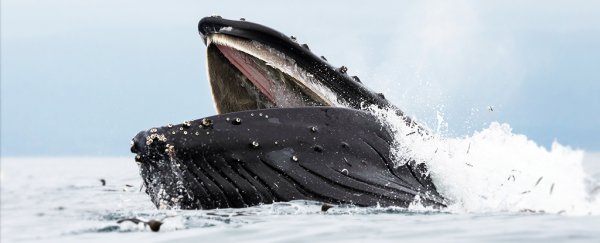ARTICLE AD
 A humpback whale (Megaptera novaeangliae). (Chase Dekker Wild-Life Images/Getty Images)
A humpback whale (Megaptera novaeangliae). (Chase Dekker Wild-Life Images/Getty Images)
The large size variation among cetacean species, including dolphins, whales, and porpoises, is largely explained by the activity of specific gene regions, according to a recent study by scientists from Brazil's University of Campinas Institute of Biology (IB-UNICAMP).
Blue whales (Balaenoptera musculus), for example, can grow up to a giant 30 meters (98 feet) long while the bottlenose dolphin (Tursiops truncatus) usually doesn't get longer than 3.5 meters. Not only does the new research help explain these massive size differences, it may also advance cancer treatments.
The researchers looked into the DNA sequence that comes before the part of a gene that codes for proteins, called the promoter region. Examination of the promoter region for a gene called NCAPG revealed intriguing relationships among cetaceans.
What's more, it's possible the regulatory sequence identified might play a role in managing any runaway proliferation of cells in animals adapted for massive growth.
Cetaceans fall into two well-defined groups; Mysticeti, which encompasses all baleen whales like humpbacks, and Odontoceti, which include whales with teeth, like sperm whales, and dolphins. Yet in spite of such distinct evolutionary classification, the entire group of aquatic mammals could be divided up another way.
"We found in the promoter region of the gene NCAPG a division between those with lengths of more or less than 10 meters – giants and non-giants," says Felipe Silva, first author of the new paper and a geneticist at IB-UNICAMP.
Previous research by the same group revealed that the NCAPG gene appears to be favored by evolution in giant cetaceans. The new findings about this gene's promoter and coding regions suggest that it plays an important role in causing cetaceans to grow to enormous sizes.
Gene activity is largely dependent on the promoter region, which is like a regulator of gene expression. Silva and his team found the size-controlling proteins were more active in giant cetaceans, at the behest of their specific promoters. In contrast, cetaceans with lengths less than 10 meters had these same genes acting as inhibitors limiting production of those proteins, and as a result, the animal's size.
"Our findings don't change the group's evolutionary tree but constitute new evidence that giant size has a genomic basis," says geneticist Mariana Nery from IB-UNICAMP.
The proteins that regulate body size were more active in giant cetaceans, explaining why the sperm whale (Physeter macrocephalus), which is giant but has teeth, is more closely related to Mysticeti, which are also giant but lack teeth.
Those same genes were inhibitors in cetaceans under 10 meters, which explains the genetic link between the 8.8 meter-long non-toothed common minke whale (Balaenoptera acutorostrata), and other toothed non-giant cetaceans.
"The analysis of other genes confirms the evolutionarily established groups," Nery explains, "meaning that the characteristics of minke whales and sperm whales are probably convergent adaptations – similar traits that evolve independently in separate groups via different routes."
Despite the expectation of tumors in animals with a large number of cells, giant cetaceans display an exceptionally low incidence of cancer.
The researchers then analyzed the regulatory regions of four genes that had previously had their protein-coding sequences studied. Non-coding sequences, which include regulatory elements like promoters and enhancers, play a role in coordinating the timing and location of gene expression.
"It was important to analyze the coding and non-coding portions of these cetaceans' genomes since both proved significant for these traits, which evolved very rapidly in these animals, as the analysis also showed," Silva explains.
The team speculated that these regulatory regions might not only have an effect on the size of cetaceans but could influence their ability to suppress cancer.
"Humans also have these genes, so it would be interesting to find out more about how they suppress the formation of tumors in these animals," says Nery.
"Such knowledge could help develop future cancer treatments via activation or inhibition of specific regions of the genome, for example."
The research has been published in BMC Ecology and Evolution.

 11 months ago
71
11 months ago
71 

